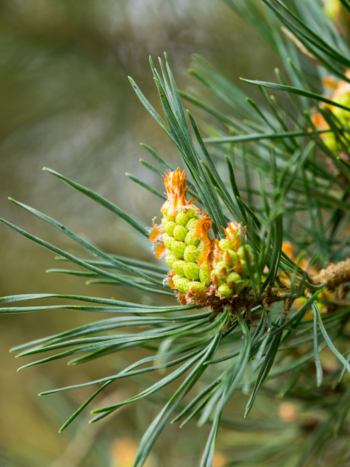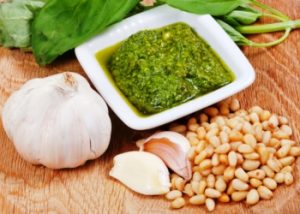Fancy, tiny pine nuts are delicious with a buttery taste adding a sweet crunch to meals. Sprinkle this superfood on salads, on vegetables and make tasty pesto with them adding nutrition and health benefits to your meal.
Health Benefits of Pine Nuts
Pine nuts have many of the same health benefits as other nuts. In numerous studies, the consumption of nuts was found to lower waist circumference, blood pressure, insulin resistance and increase high cholesterol.
Appetite Suppressant
An appetite-suppressing hormone (cholecystokinin) is released from the fatty acids in pine nuts. When women in a study consumed fatty acid (pinolenic acid from the pine nut) before breakfast it was found to lower the amount of food eaten by 37 percent. Pine nut oil was found to help overweight, post-menopausal women suppress their appetite in a study by Dr. Pasman.
Healthier Weight Maintenance
Research has found that those who eat nuts regularly are at a healthy weight because they are getting more fiber, Vitamin E, calcium, magnesium, and potassium according to statistics.
Lowers Bad Cholesterol
Improved cholesterol levels from including mixed nuts (walnuts, peanuts, and pine nuts) as part of the diet for six weeks in a Korean study showed an improvement in cholesterol levels.
Other research has shown a reduction in bad cholesterol levels.
Lowers Heart Disease
It was found that there was a decrease in cardiovascular disease in participants that ate one-quarter ounce of nuts per day in a 1999-2004 study.
Note: As with all nuts, they have been known to cause allergic reactions. There is a rare allergic reaction to pine nuts is known as Pine Mouth Syndrome which can last a few weeks but it is not dangerous. When one has it there is a bitter or metallic taste after eating pine nuts.
The Process of Growing and Harvesting Pine Nuts is Expensive
They are actually the seeds of pine trees and not really nuts. They are seeds found in the pine cones.
They come from a variety of pine trees; there are about 18 pine trees that produce nuts worthy as food. These trees are found in Europe, Russia, Mongolia, Eastern Siberia, and North Korea and North America. There are eight varieties that grow in cold climates such as Canada.
It can take at least 10 years to get pine nuts from a tree; first, it takes 6-8 years for the tree to mature fully and then 2-3 more years to develop the pine nuts. They ripen in late summer or early fall.
Once harvested, next is the drying process: they are placed in a burlap bag and exposed to heat which is usually the sun, to dry out the cone for about 20 days. The outer shell must be removed, the cones are broken apart and the seeds are taken out. All of this is time-consuming just to get a small nut so this is one of the reasons they are expensive.
Pine Nut Nutrients
One ounce serving (165 pine nuts) contains a wide variety of nutrients (potassium, protein, iron, magnesium, phosphorus, zinc, thiamin, niacin, Vitamin E, Vitamin K and more) Go here for more nutrition details.
Trivia
- In one ounce of pine nuts, there are about 165 pine nuts.
- They have been consumed by people since prehistoric times.
- They used the crushed nuts for the treatment of burns; pitch for the treatment of wounds; and smoke from burning branches for treatment of coughs, colds, and rheumatism.
- Spain is the leader in pine nut production.
History
- Since Stone Age times they have been consumed; remains have been found in caves in southern France. The pine nut tree has been cultivated since about 4000 BCE according to Archaeologists.
- They have been harvested for over 8,000 years. There is proof of them being found in excavations at Gatecliff Shelter, Nevada, 6,000 years BCE.
How to Select
Look for shelled nuts that are stored in air-tight plastic bags in the stores. Make sure they are fresh and have not lost their light colour.
How to Store
It is important, due to their high-fat content, to store them in the refrigerator for 1 – 2 months or they need to be kept in an airtight container or in the freezer for up to 9 months. At room temperature, they will only last for a week before going rancid.
Tips for eating or cooking
They are delicious raw but you can also eat them roasted, adding a sweet nutty flavour and crunch to vegetable dishes and salads. Of course, there is delicious pesto.
Here are 2 tasty recipes:

Delicious Vegan Pesto – Enjoy pine nuts in this easy to make recipe.
Zucchini Pesto – Another tasty recipe for you.
100+ Superfoods
Learn more about some of the healthiest vegetarian foods you will always want to have in your pantry or growing on your deck.
READ: Superfoods – Over 100 of the Healthiest Foods You Should Have in Your Diet and learn more about the variety of Superfoods we think you should have in your diet.

